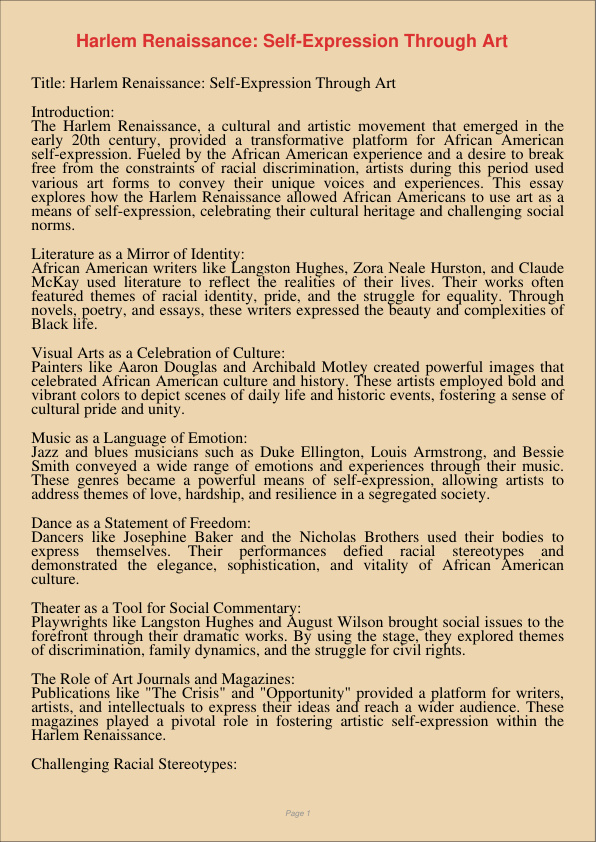Harlem Renaissance SelfExpression Through Art
Jan 9, 2024
harlem renaissance
self
Literature
Religion and Theology
Title: Harlem Renaissance: Self-Expression Through Art
Introduction: The Harlem Renaissance, a cultural and artistic movement that emerged in the early 20th century, provided a transformative platform for African American self-expression. Fueled by the African American experience and a desire to break free from the constraints of racial discrimination, artists during this period used various art forms to convey their unique voices and experiences. This essay explores how the Harlem Renaissance allowed African Americans to use art as a means of self-expression, celebrating their cultural heritage and challenging social norms.
Literature as a Mirror of Identity: African American writers like Langston Hughes, Zora Neale Hurston, and Claude McKay used literature to reflect the realities of their lives. Their works often featured themes of racial identity, pride, and the struggle for equality. Through novels, poetry, and essays, these writers expressed the beauty and complexities of Black life.
Visual Arts as a Celebration of Culture: Painters like Aaron Douglas and Archibald Motley created powerful images that celebrated African American culture and history. These artists employed bold and vibrant colors to depict scenes of daily life and historic events, fostering a sense of cultural pride and unity.
Music as a Language of Emotion: Jazz and blues musicians such as Duke Ellington, Louis Armstrong, and Bessie Smith conveyed a wide range of emotions and experiences through their music. These genres became a powerful means of self-expression, allowing artists to address themes of love, hardship, and resilience in a segregated society.
Dance as a Statement of Freedom: Dancers like Josephine Baker and the Nicholas Brothers used their bodies to express themselves. Their performances defied racial stereotypes and demonstrated the elegance, sophistication, and vitality of African American culture.
Theater as a Tool for Social Commentary: Playwrights like Langston Hughes and August Wilson brought social issues to the forefront through their dramatic works. By using the stage, they explored themes of discrimination, family dynamics, and the struggle for civil rights.
The Role of Art Journals and Magazines: Publications like “The Crisis” and “Opportunity” provided a platform for writers, artists, and intellectuals to express their ideas and reach a wider audience. These magazines played a pivotal role in fostering artistic self-expression within the Harlem Renaissance.
Challenging Racial Stereotypes: Through their art, Harlem Renaissance figures challenged harmful racial stereotypes that had long plagued African Americans. They portrayed Black individuals as complex, multifaceted, and capable of excellence in all artistic endeavors.
Legacy and Ongoing Influence: The Harlem Renaissance not only allowed for self-expression but also left a lasting legacy. It influenced subsequent generations of artists, contributing to the Civil Rights Movement and the broader acknowledgment of African American contributions to American culture.
Conclusion:
The Harlem Renaissance stands as a testament to the power of art in self-expression. African American artists used literature, visual arts, music, dance, theater, and publications to convey their unique experiences, challenge racial stereotypes, and celebrate their cultural heritage. This period in history demonstrated that art is not only a form of expression but also a vehicle for social change, and its legacy continues to inspire and empower artists today.
